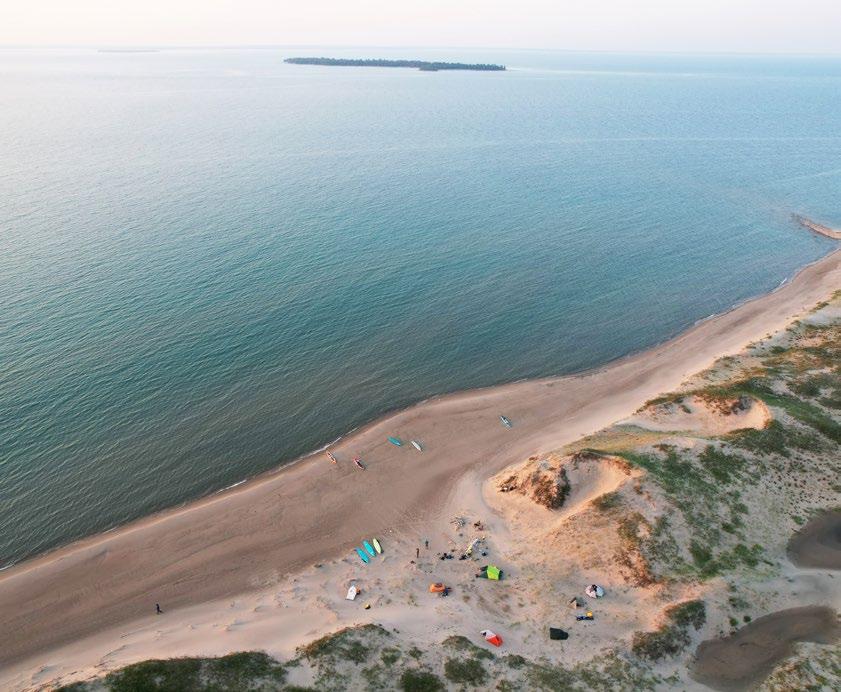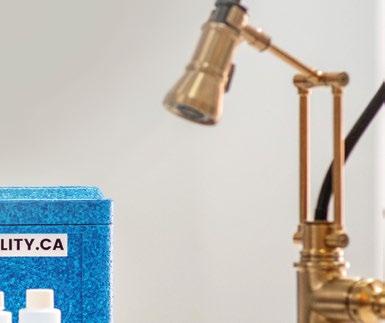
8 minute read
Voyage to the Windy Islands
to the
A SUP trip to a remote island group reveals both the solace of nature and the long reach of the pollution crisis
words :: Ned Morgan
Iwas alone—shouting at the water and the sky. After more than six hours paddling into the wind, I had reached a personal crisis point. From the moment our party of eight paddleboarders emerged early (-ish) that morning from a bay on the mainland, leaving our vehicles at the end of a chassis-cracking bush road, the wind did everything it could to throw us off course. Our destination—a sand beach on the west side of Big Windy Island*— was about 14 unsheltered kilometres from our launch. When the wind really stiffened by late morning, pulling over would have made sense. But the rocky shorelines of two smaller islands we passed were too exposed; if we stopped, we could get marooned if the wind came up even higher.
For about half the crossing, a side wind threatened to push us out into open water, with no landfall for hundreds of kilometres. Then, alongside Big Windy, we changed direction and found ourselves struggling against a headwind that wanted to push us back where we’d started. My inflatable SUP didn’t cut through the water as nicely as the others’ fibreglass boards and I fell far behind the rest of the group, the perceived handicap of my board nagging at me as much as the difficulty of trying to make progress in the face of a 45 kilometre-per-hour wind.
I decided to crouch on my knees as I paddled, in an effort to duck the wind. It seemed to help, though my progress was still torturously slow. After lurching around a long, forested point as breakers threw off my steering, I stopped paddling and began screaming invectives, my head in my hands. My arms felt rubbery and useless. I didn’t care anymore.
From the moment our party emerged from a bay on the mainland that morning, the wind did everything it could to throw us off course.


When I looked up, I found myself in a small, relatively sheltered bay. Through the aquarium-clear water I noticed countless smooth, multicoloured rocks that seemed deliberately arranged on the lakebed for their complementary beauty, like a huge, sun-streaked mosaic. I slid off my board. As I stood in the waist-deep water—cooly welcoming on this mid-July afternoon—my feet on the rocks felt reassuring after so many hours on the board. With the wind still unceasing, I decided it was easier to unravel my throw rope and pull my board through the shallows. I wasn’t in a rush anymore; it was still only mid-afternoon and I knew our beach destination was less than two more kilometres away. Everyone else was already there.
I realized the splendour of this place was due to what it lacked. In the absence of people, the biosphere thrived all around me. I watched an Arctic tern skim the churning water, crying out keenly. As it scooped up a small fish I admired the bird’s consummate skill, using the wind and water to influence and guide its every move. I felt I could learn from a creature that, instead of struggling against its environment, simply observed closely and adapted continuously without over-analysis.
When I stood up to paddle, the wind began pushing me sideways. But I dug in, focusing on each stroke rather than on my slow progress. With a feeling of speechless relief I finally arrived at the beach, now adorned with paddleboards and exploded camping gear. Someone handed me a cold (-ish) can of beer. Everything was good now.
Then as I carried my gear across the beach to the tent site I noticed a children’s helium balloon—long-deflated, all multicoloured foil and tassels, wrecked by wave action but still identifiable as a
Camp in the dunes on the lee side of Big Windy Island. SCOTT PARENT



butterfly. Our trip leader Scott Parent spotted it on shore earlier that day and had pulled over to recover it. We packed it out—the first of many pieces of mostly plastic garbage we recovered.
It was jarring and a little depressing to find the balloon washed up in this otherwise wild place. I reflected glumly that earlier in the summer I purchased a similar balloon for my fiveyear-old daughter; I wasn’t blameless in the mounting pollution crisis we’re all living through but don’t want to confront.
Over the next few days we endured a tent-flooding all-day rain, paddled through two-metre swells and explored the footprint-free beaches. Every step lent a Robinson Crusoe feeling as we walked for hours, marvelling at the multi-leveled expanse of dunes overgrown with bearberry, creeping juniper, heartleaf willow and sand reedgrass—a primeval, fragile ecosystem which has been all but wiped out across the Great Lakes.
The island interior was a tangled maze of old-growth cedar, spruce, birch and pine, each bedecked in lichens and moss and stunted by exposure to constant winds and colder temperatures than the mainland. During the rain day, a few guys in our group followed the remnants of a trail into the interior, probably used many years ago as a passage between the east (lee) and west (windward) sides of the island. It felt as though this place hadn’t changed much in thousands of years. Its isolation was, and remains, its salvation.
On the final day of the trip, we took stock of the debris we had collected along the shorelines and scrunched under our decks’ shock cords: the big balloon plus smaller ones, water and detergent bottles, plastic bags, aluminum cans, nylon rope and bobbers. We found no litter associated with camping and no trace of campsites. We kept it this way.
My Water Quality
Tens of thousands of Ontarians make their way north every weekend. Packing kids, gear and coolers, the familiar trip inevitably includes a quick stop: grab a carton of milk, a dozen eggs and, for many, a case or two of bottled water. The much-maligned crinkly bottles make their way to cottages and chalets, century homes and condos. Purchased for one-time use, they’re drained and immediately tossed. By Sunday night bins overfl ow, and after a long work week the story begins again. Cases upon cases of water, nearly every drop tainted with microplastics, follow the same path. Without the encouragement of a deposit refund, every year only half of the 2 billion single-use beverage bottles sold in Ontario end up in the recycling bin. The other billion make their way to landfi lls—or are discarded or blown onto streets and ravines, where rain washes many of them into our waterways. Use of disposable water bottles is completely avoidable for most Ontarians (boil orders notwithstanding). The sticker-plastered Nalgene is as ubiquitous to the outdoors as the crumbled granola bar in your day pack; sleek and shining stainless steel bottles are as accepted on the jobsite as they are in a Tesla. And a quick refi ll from a tap is usually just steps away. But for those who jump on the weekly single-use-bottle conveyor belt, that tap water is often the issue. New to rural life with a well, uncomfortable with a lakesourced pump or concerned about ancient pipes in an older house, homeowners often just aren’t sure about their tap water. It kind of has a funny smell. Or maybe the colour is a little off. Sometimes it just doesn’t taste like the water they’re used to. Unsure of how to test the water, or fearful of the cost, disposable bottles seem an easy solution. Tecia White, a local hydrogeologist, has a growing frustration with bottled water use, and with homeowners’ assumption the water is cleaner and better than their own. “It’s really about knowledge and confi dence. Once a homeowner has knowledge about their own tap water, they have the confi dence to stop using bottled water,” she says.

“It’s really about knowledge and confi dence. Once a homeowner has knowledge about their own tap water, they have the confi dence to stop using bottled water.” – Tecia White, hydrogeologist
Homeowners have long reached out to White’s environmental consulting fi rm for water testing, but, because the company focuses on larger-scale assessments, the process could be time-consuming and expensive. Hoping to empower more residents to ditch the bottles, she streamlined the process and launched a new venture: MyWaterQuality.ca.
To continue reading, go to www.mountainlifemedia.ca/ mywaterquality




Full dune immersion. SCOTT PARENT
While packing up on the last day, I found an eagle feather on the dunes and took it home to give to my daughter. It was a small gift I hoped she’d treasure much longer than a helium balloon. I’d love to show her the islands someday, but perhaps it’s better if we settle for the feather. People, like balloons, don’t really belong on the Windy Islands. *We chose to both use a pseudonym and withhold the location of the remote Great Lakes island group we visited. Too much human visitation to the Windy Islands (an unstaffed nature reserve) could have a catastrophic impact. Camping is permitted here but by no means encouraged. The islands lie far from any marina, and the presence of encircling shoals further dissuades power boats. In summer a handful of intrepid sailors may navigate the shallows to stop in the single safe (-ish) anchorage and the odd kayak party may land on the Windy Islands, but we saw no sign of anyone, past or present.












